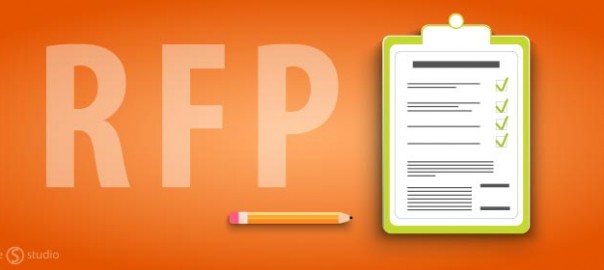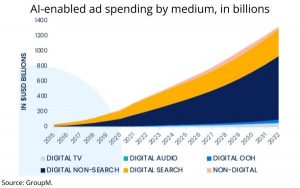Selecting the right agency partner for your firm’s website redesign project is one of the most crucial steps in the entire process. It’s not an overstatement to say that success hinges on it. And developing the right kind of RFP upfront plays a big role in a successful selection.

Developing and distributing an RFP (request for proposal) to potential digital agency partners is a very common component of the website redesign planning process. But many firms find developing RFPs challenging—unsure of what to include, how to format it, what to ask for and how to approach it. Having received and responded to numerous RFPs, I thought I’d share some tips that, based on our experience, could greatly improve the website redesign RFP and the selection process.
1. Don’t write an RFP before you’re ready
Planning a successful website redesign is a long and involved process, and writing an RFP shouldn’t be the beginning of that process. Instead, time should be devoted upfront to researching the key needs that will have the largest impact on scope and cost. These details will help to provide a clearer picture to the submitting agencies of the site they are being asked to build. The more detail you can provide, the more likely they will be able to provide you with a fair and accurate estimate.
2. Identify a short list of potential agencies you may want to work with first
When we receive an RFP, we often ask how many other agencies received it as well. Naturally, we cringe when we regularly hear that 10 or more agencies will also be submitting proposals. And that’s not because we don’t like competition! But rather because it’s highly unlikely that all 10 or more agencies meet all points of the selection criteria and are legitimate contenders for winning the project.
Instead of sending the RFP to a large group of agencies, we suggest doing some due diligence upfront to narrow down your options. Consider what your selection criteria will be and rule out the agencies that don’t sufficiently meet your must-haves. Here are a few examples:
• If proximity to your office is a critical factor, don’t send your RFP to agencies that are out of the area.
• If you’re a global firm looking for a global agency, don’t send to firms without a global presence.
• If you’re looking to build on a shoestring budget, don’t send to agencies whose portfolio reflects bigger clients and/or budgets.
• If you’re looking for an agency with specific industry expertise, don’t send to agencies without that expertise.
Spending time upfront to narrow down your options will save you the time of reading proposals from agencies that do not meet your needs.
3. Set up preliminary meetings with your shortlist in advance of the RFP
Once you have determined your initial shortlist of qualified agencies, we recommend setting up preliminary meetings or conference calls with each one. This is an opportunity to continue the due diligence process and whittle down your shortlist even further. These meetings provide a forum to discuss your redesign project, seek input and recommendations and ask important questions that will influence your RFP.
Similar to the previous step, there may be some deal breakers that get uncovered during these meetings. Things like the agency’s process, personalities or bandwidth and availability may prove to be problematic. Coming out of these meetings, you should have a much better understanding of what you’ll want to include in your RFP and which agencies you truly want to invite to the table.
4. Identify the goals and priorities of your redesign
It’s incredibly helpful for a potential redesign partner to have a clear understanding of the overarching goals of the redesign, as well as the more specific priorities. Be sure to identify the reason for the redesign, the problems you are trying to solve, the challenges you want to overcome and the ways in which you want your new website to be different from the one you have now.
You’ll also likely have a budget, so the sky might not be the limit for what you’re able to build. Therefore it’s important for a potential agency partner to understand what the top priorities are for the redesign in order to focus on what matters most.
5. Clearly define the scope and technical requirements
This is where the majority of website redesign RFPs fall short—failing to clearly define the scope of the project and the technical requirements. Nearly every RFP asks the agency to provide a specific price estimate, and many times asks for a detailed breakdown of the fees and associated costs. The immense difficulty for the agency lies in trying to put a specific and detailed price on an undefined scope.
I liken it to building a house. If you ask a builder for a price to build your new home, they will first want a deep understanding of your wants and needs. In addition to basic specs like square footage and number of stories, they’ll want to know about things like materials, appliances and other finishes before providing an accurate estimate.
The same is true of websites. The amount of planning, design and customization required all have a significant impact on the final cost. To ensure a fair and accurate estimate that leads to no surprises down the road, you need to clearly define the scope and technical requirements in your RFP.
6. Don’t ask for specifics, while providing generalities
You need to be as detailed as possible and give specific examples in your RFP. If there are particular features and functionality that you desire, provide URLs to websites that showcase examples. Terms like “cutting-edge” or “interactive” can mean different things to different people. Define what terms like this mean to you and, where possible, provide examples.
There are also other components such as brand refreshes, copywriting, video production, content development, marketing automation, CRM integration, etc. that are often lumped into redesign projects and will need to be clearly explained. For example, if you need copywriting, provide information on the type and amount of copy required (i.e. sections, pages, headlines, etc.). The more specific you are in your RFP, the more specific response you’ll get in proposals.
7. Share your budget
Along similar lines, the first thing a builder or realtor is going to ask a homebuyer is what their budget is. And this makes complete sense! You have to know where the limits are and it’s the builder or realtor’s job to make sure you can afford your dream house and, if necessary, can dial back the specs to fit the budget.
The same is true with websites. Sometimes the wish list for a client is just not possible based on their budget limitations. If that is the case, it’s important for each agency to have the opportunity to address the situation and offer suggestions of what is and isn’t possible within the constraints of the budget. The agency’s job is to balance the website goals, priorities, wish list and the budget to deliver a great website. Each may come at the solution differently, but knowing the budget helps to define the playing field for everyone responding to your RFP.
8. Explain your evaluation process, project timeline and follow-up with all parties involved
Last but not least, it’s helpful to explain your evaluation and selection process and lay out a timeline for your project. In addition to the due date of the proposal, provide your timeframe for shortlisting agencies, your plan for interviewing, the date you plan to make a final selection, when you want the project to kickoff and your desired date to launch the website.
One best practice we have found from the A/E/C industry is to follow up with any candidates who were not shortlisted or selected for a debrief. For agencies who are continuously seeking to raise the bar, it’s always helpful and appreciated to hear the final decision and the factors that lead to the ultimate selection.
/ / /
The RFP process can be complex and time consuming. But by following these tips, you can improve your process and develop an RFP that positions your project for success.
(207)






